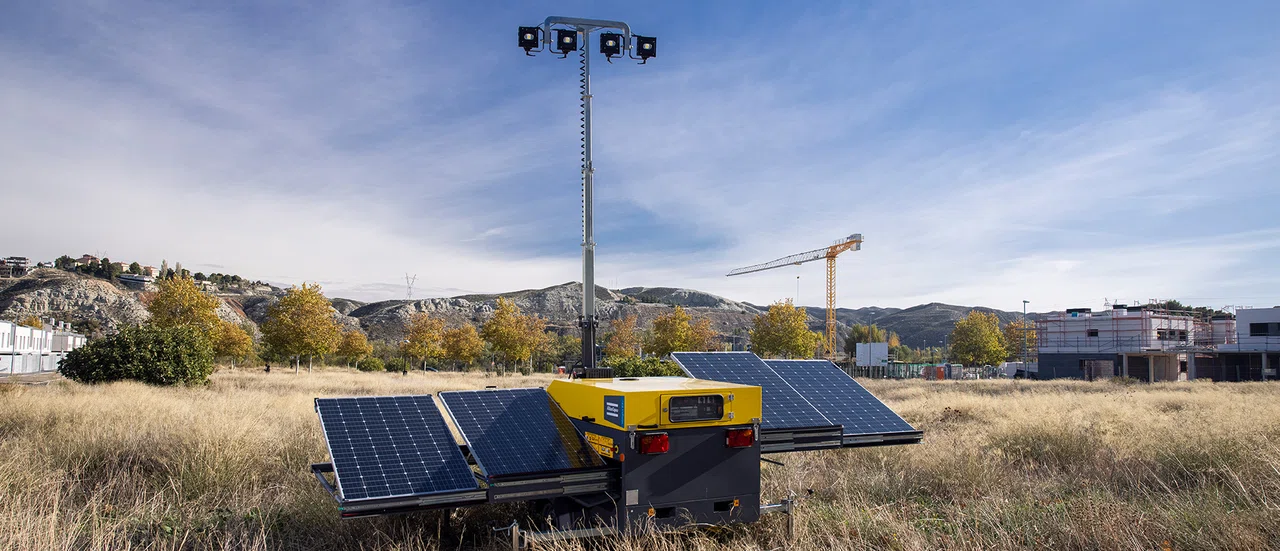Follow us on:
CONTACT US | Download the 2021/2022 issue | ©Atlas Copco AB



result
Search
A MAGAZINE FROM ATLAS COPCO GROUP
Sustainable technologies
Markets
Smart manufacturing
Our culture
Service and Consulting
Energy efficiency
From sun
to site
Tougher emission requirements and raised ambitions are making construction and mining industries shift to low or zero-carbon equipment. This solar-powered light tower is lighting the way.
Imagine a flexible and durable light tower which can illuminate a 2,000m site area for up to 11 hours, while preventing emissions of up to six tons of CO2 per year. This is the not so secret superpower of Atlas Copco’s HiLight S2+ solar light tower, launched in 2021.
In regions with strong sunlight, such as the Middle East and Australia, this solar light tower is completely autonomous, fully recharging in six to eight hours. Elsewhere, a tower’s autonomy can be extended to up to 20 hours thanks to a modular design that allows the number of batteries installed to be upgraded. In regions with little sunshine in the winter, the unit requires supplementary charging from a battery energy storage system, such as the Atlas Copco Zenergize ZBP45.
“Many customers are really committed to reducing their CO2 footprint, and others see that if they don’t minimize their emissions, they will be out of the game,” says Felix Gomez, Product Marketing Manager in Atlas Copco’s Power and Flow division.
Wings of a bird
This sustainable innovation is the result of a collaboration between the Power and Flow team in Zaragoza, Spain and the manufacturing team in Wuxi, China. The new features are based on the customer response to Atlas Copco’s first solar light tower, the QLTS, which came market in 2014.
The development project was a collaboration between the Power and Flow team in Spain and the manufacturing team in Wuxi, China. Designed for difficult terrains and crowded construction sites, one of the improvements is the extendable panels that can be folded inside the canopy to avoid damage during storage and transport. According to Qiangwx Li, Engineering Manager in Wuxi, the extendable panel solution was inspired by nature’s own design.
“It came like a flash into my mind, and I thought that the machine could expand, like the wings of a bird, and then when it's not being used the panels can be stored inside,” he remembers. “It means you can tow it anywhere without worrying about the solar panels cracking or being hit by a stone, and it also makes the whole machine neat and easy to store.”
This solution presented a complex engineering challenge for He Chi, Engineering Team Leader, particularly as the panels needed to adjust to face the sun.
“It was so difficult,” she says. “I needed to design a solar panel expanding system which allows solar panels be stored in one rack, in four layers, but which could be expanded to 5.4m wide.”
Apart from one month of the design process, when Wuxi was in pandemic lockdown, He Chi came into the factory frequently to test various solutions. “I’m so excited,” she adds of the first deliveries to customers. “It’s like my child.”
Compact footprint
Apart from the obvious climate benefits, the HiLight S2+’s zero noise operation is a key advantage, not least in housing areas or at major public events. The light tower’s low maintenance also appeals to mining companies. Whereas a standard diesel light tower needs frequent refueling and a change in oil filters every 500 hours, the S2+ is close to maintenance-free. In the event of a fault, the canopy flips up, giving easy access to all batteries and wiring.
The light coverage is a third of that produced by Atlas Copco's popular HiLight H6+ diesel towers, so for some construction sites the S2+ is best used to light non-critical areas such as worker accommodation and parking. A light tower with greater coverage would currently be too expensive and take up too large an area, but with solar and battery technology improving rapidly, this will change.

Many customers are really committed to reducing their CO2 footprint, and others see that if they don’t minimize their emissions, they will be out of the game,”

Felix Gomez
Product Marketing Manager,
Atlas Copco’s Power and Flow division

“This was a good compromise that matches customer needs today and in the near future,” Gomez concludes. “As soon as technology decreases the cost and increases the efficiency, we will start innovating to see how this light tower can get wider light coverage, an even more compact footprint and greater autonomy.”




